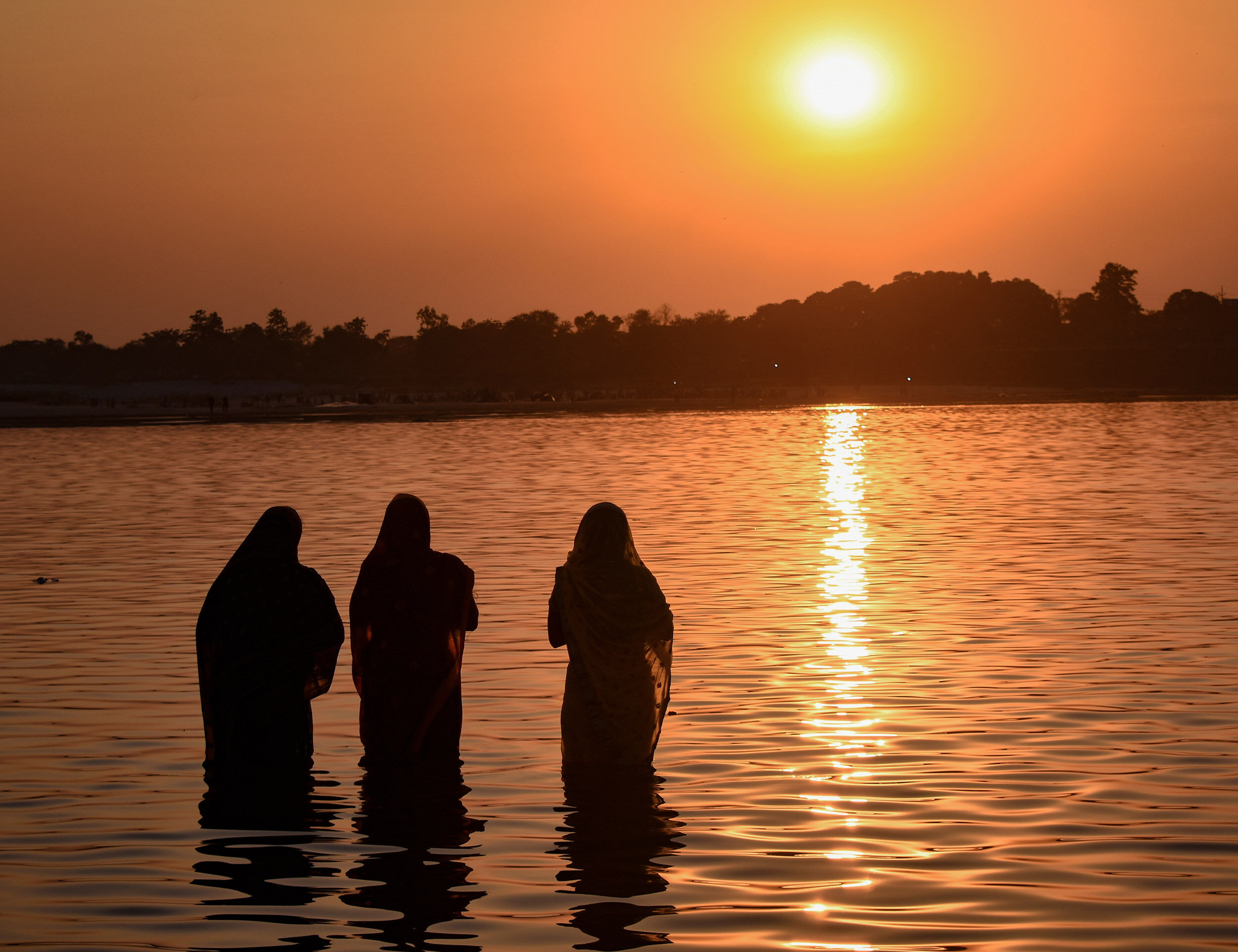STORIES BY DIWAS

Lifestyle
Tracing the Chhath Puja Story Through Indian History
Date 17 October 2025 Reading time: 7-10 mins
The Chhath Puja story runs deeper than most realise, weaving through centuries of Indian mythology, family traditions, and cultural identity. What makes this four-day celebration so distinctive is its unwavering focus on sun worship and gratitude for life's blessings. Unlike most festivals centred around temple visits or idol worship, the Chhath Puja history involves direct communion with natural elements, primarily the sun and water.
As wedding season approaches in Bihar, Jharkhand, and parts of Uttar Pradesh, many families schedule their celebrations around Chhath, understanding its deep-rooted importance in community life. Let's dive into the fascinating story behind Chhath Puja and discover why this solar festival continues to shine brightly in Indian cultural consciousness.
The Origin of Chhath Puja
The Chhath Puja history stretches back to Vedic times, with scholars finding references in ancient texts like the Rigveda, which contain hymns praising Surya, the Sun God.
The earliest documented Chhath Puja story connects to the understanding that without sunlight, life on earth would cease to exist. Our ancestors recognised this dependency and created rituals to express gratitude to this life-sustaining celestial body.
Archaeological evidence suggests sun worship rituals similar to modern Chhath practices existed over 4,000 years ago in the ancient Indus Valley civilisation. However, the festival as we know it today took a more defined shape during the early Vedic period when the importance of sun worship gained prominence in daily life.
What's particularly fascinating is how it survived centuries of cultural changes, foreign invasions, and shifting religious practices. While many ancient rituals faded away, Chhath persisted, especially in the Mithila region spanning present-day Bihar and parts of Nepal.
The Evolution of Chhath Puja
History reveals how this once strictly Vedic ritual transformed into a more inclusive folk tradition that transcended caste and class barriers. During the medieval period, the Chhath Puja story took interesting turns. While royal patronage helped preserve many aspects of the ritual, common people added their elements, making it more accessible.
By the 19th century, Chhath had become firmly established as a cornerstone of cultural identity in Bihar and surrounding regions. The British colonial records mention the festival's widespread observance, noting the striking sight of devotees standing in water bodies during sunrise and sunset.
The post-independence era brought new dimensions to the story. As people from Bihar migrated across India for work and opportunities, they carried their beloved festival with them. Today, Chhath celebrations can be witnessed in Delhi, Mumbai, Kolkata, and even abroad, wherever the diaspora has settled. The Chhath Puja importance remains unchanged, but the methods have adapted to modern living conditions.
The Chhath Puja Story
The Chhath Puja story intertwines mythology, history, and spirituality, creating a rich narrative that explains both the "how" and "why" of this ancient practice.
One of the most widely accepted accounts links Chhath to the epic Ramayana. According to this story, when Lord Rama and Sita returned to Ayodhya after defeating Ravana, they observed a fast and offered prayers to the Sun God in gratitude. This ritual, performed on the banks of the Saryu River, is considered the prototype for modern Chhath celebrations.
The Mahabharata connection offers another fascinating angle to its history. Karna, the generous warrior who was the son of Surya and Kunti, performed similar sun worship rituals, standing in water. His devotion to his father, the Sun God, is reflected in current Chhath practices.
There's also a lesser-known but compelling story about Draupadi and the Pandavas performing sun-worship rituals to regain their lost kingdom. This narrative emphasises the Chhath Puja as a means to overcome hardships and achieve prosperity.
Chhath Puja Story in Hindi
"हमारे पूर्वज सूर्य देव की शक्ति और महत्व को समझते थे। छठ पूजा की कहानी इस ज्ञान से जुड़ी है," explains Bihar-based cultural historian Dr. Rajesh Kumar. The Chhath Puja story sounds most authentic when narrated in Hindi or Bhojpuri, the languages of the regions where it originated.
In Hindi storytelling tradition, the Chhath Puja history often begins with "प्राचीन काल में..." (In ancient times...), setting the stage for tales of royal families performing elaborate sun worship rituals. These narratives typically highlight the transformative power of devotion and discipline, central themes in Chhath observance.
Folk songs in Hindi and regional languages preserve many aspects of the story behind Chhath Puja that might otherwise have been lost. These songs, passed down through generations, detail not just the mythological origins but also the correct procedures for each ritual.
"छठी मैया की कहानी हर घर में अलग होती है, पर भावना एक ही होती है—कृतज्ञता की," notes folk artist Shanti Devi. This sentiment captures how personal family histories now intertwine with the larger Chhath Puja importance, creating thousands of micro-narratives within the grand tradition.
Chhath Puja Story in English
When translated into English, the Chhath Puja story sometimes loses its cultural nuances but gains wider accessibility. Contemporary English retellings focus on the scientific and health benefits of the rituals, appealing to younger, globally minded Indians.
The English narrative of its history often emphasises its scientific basis—how standing in water during sunrise exposes devotees to beneficial solar rays while the water provides cooling protection. The 36-hour fast is framed as a detoxification process, and the ritual foods as nutritionally balanced seasonal offerings.
Modern English descriptions of the story behind Chhath Puja frequently highlight its environmentally conscious aspects. The Chhath Puja importance in English narratives also stresses community building and family bonding. As one blogger puts it, "Chhath brings entire neighbourhoods together in preparation and celebration, creating social cohesion that's increasingly rare in our individualistic world."
The Cultural Relevance of Chhath Puja
Beyond religious significance, the Chhath Puja story reveals fascinating insights into Indian cultural values and social structures. This festival stands out for its strong female leadership, unusual in many Hindu rituals where male priests typically dominate.
During Chhath, it's primarily women who undertake the demanding fast and lead the ceremonies. This matriarchal aspect of the Chhath Puja history speaks to the important role of women as family caretakers and spiritual guides. The festival honours female strength and endurance, with men taking supporting roles.
The story behind Chhath Puja also highlights India's agricultural heritage. The timing coincides with the end of the harvest season in Bihar and neighbouring regions. In modern India, Chhath serves as a powerful cultural identifier. The Chhath Puja importance extends beyond religious devotion to become an assertion of regional identity and cultural pride.
The cultural impact extends to art, music, and literature. The Chhath Puja story has inspired countless folk songs, paintings, and poems that capture its spiritual essence and communal joy. Modern Bollywood has featured Chhath scenes in films depicting Bihar, further popularising the festival nationally.
The Importance of Chhath Puja
The Chhath Puja story stands as a testament to India's living heritage, a tradition that has not just survived but thrived through millennia. The Chhath Puja history reminds us that at our core, humans have always sought to express gratitude for life's fundamental gifts—sunlight, water, food, and community.
Understanding the story behind Chhath Puja enriches our appreciation of India's cultural diversity. While primarily associated with Bihar and specific regions, the festival represents values universal to Indian philosophy—gratitude, discipline, family bonds, and harmony with nature.
As the festival continues to spread globally with the Indian diaspora, the Chhath Puja importance will likely gain new dimensions while preserving its essential character.
Whether you're participating in Chhath celebrations or simply appreciating its cultural significance, dressing appropriately shows respect for tradition. Explore Diwas's complete collection to find the perfect outfit honouring heritage and personal style.



